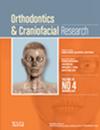Clinical Effectiveness of Upper Vacuum-Formed Retainers Used in A Dual Retention Protocol After Orthodontic Treatment: Retainer Failures and Upper Arch Stability. A 24-Month Prospective Cohort Study
Abstract
Objectives
This prospective cohort study aimed to evaluate the number of failures of upper vacuum-formed retainers (VFRs) used in a dual retention protocol and the capacity to maintain upper arch stability 24 months after debonding.
Material and Methods
At the end of orthodontic treatment (T0), 93 consecutive patients (12–25 years) received an upper VFR for night-time use and a fixed retainer. The patients were seen 12 (T1) and 24 months (T2) after debonding. At both time points, the status of the VFR was checked. Intraoral scans were taken at T2. Upper arch dimensions were measured at both time points and compared with paired sample t-tests.
Results
Eighty-three and 78 patients attended the T1 and T2 controls respectively. At T1, VFR failures were recorded in 28 out of 83 patients; and at T2, in 36 of 78 patients. The most common type of failure was occlusal wear (T1: 10, T2: 23). Three VFRs were fractured at T1 and 7 at T2. The upper intercanine width did not change statistically significantly from T0 to T2 (mean difference: −0.06 mm, SD: 0.74 mm, p = 0.242). Interpremolar distance (mean difference: 0.49 mm, SD: 0.97 mm, p < 0.001), intermolar distance (mean difference: 0.46 mm, SD: 1.49 mm, p = 0.003) and arch length (mean difference: −0.30 mm, SD: 0.71 mm, p < 0.001) were statistically significantly different between T0 and T2, but the difference was not clinically relevant.
Conclusion
VFRs present a high failure rate at 24 months, mostly because of occlusal wear and fracture. Upper arch dimensions remained fairly stable 2 years post-treatment.

 求助内容:
求助内容: 应助结果提醒方式:
应助结果提醒方式:


